The future method, sometimes called the lightened method, using bands to decrease resistance at the top of a lift, is typically seen being used in lifts like the squat and bench press.
While often associated with powerlifting, the lightened method offers a powerful approach to strength, speed, and joint-specific training applicable to any training program.
One of the reasons I admire Louie Simmons is his open-mindedness and willingness to try anything if it means getting better. That’s where I first learned about the future method.
“Use your imagination… One must take advantage of all training methods to succeed… Take advantage of everything at your disposal.”
What is the future method?
The future, or lightened method, involves using bands to create accommodating resistance, which decreases the effective load at the bottom of a lift and increases it at the top. For instance, if you attach a band to the top of a power rack and onto the bar that is on the floor or pins and perform a deadlift variation (shown in the video example further down).
Accommodating resistance refers to resistance that changes throughout the range of motion of an exercise.
Louie Simmons and his Westside Barbell club would use this method to perform squats, pulls, bench press, JM presses, and anything else a band could attach to.
Depending on the different lifts and the load they wanted, Louie and his team would use several different strengths of bands. For benching, they would use light bands or monster mini-bands, and for pulls, they would use a strong band.
Benefits for Strength and Speed
Because the bands act as a unique form of resistance and change the force-posture curve, they help an athlete build speed or absolute strength, depending on band tension and load involved, while simultaneously staving off neurological stagnation and biological accommodation simply by sprinkling on some creativity.
To elaborate, the lightened method allows for targeted development of specific qualities. For more speed-strength and acceleration, a lighter load is used at faster velocities, emphasizing the acceleration phase throughout the entirety of the lift. This approach enhances the rate of force development and improves power output. Conversely, training for absolute strength utilizes a greater load at a slow velocity, focusing on maximal force production and building absolute strength.
This variation in load and velocity, facilitated by the dynamic resistance of bands, provides a novel stimulus that helps prevent neurological stagnation and biological accommodation. Neurological stagnation occurs when the nervous system becomes accustomed to a repetitive movement pattern and stimuli, leading to decreased motor unit recruitment and reduced performance gains. Biological accommodation refers to the body's tendency to adapt to consistent stress, resulting in diminished training adaptations. By incorporating the varying resistance of bands, the lightened method challenges the nervous system with variable loads and movement patterns, promoting continuous adaptation and improved performance. Essentially, it keeps the nervous system engaged and prevents the body from becoming too efficient at a single movement, thus requiring greater force production to complete the exercise.
The video above demonstrates the usage of light-band tension anchored to the top of a power rack that is then connected to the bar. This is an example of a rack pull for maximal strength.
Benefits for Joints and Connective Tissue Training
Accommodating resistance in joint-specific training is a potent stimulus.
We can set the band tension up in such a way that it assists us in exploring end ranges of motion and loading connective tissues. The band acts as an assistant, allowing the trainee to relax and be pulled into ranges and tissues more passively.
In our last couple of training blocks at A.C.C.E.S., we have utilized this method to train the hip joint, specifically the joint capsule, the anterior spine, and the iliopsoas.
Using the bands trains specific behavioral qualities of the connective tissue such as load-bearing capacity, the ability to lengthen, and improves the connective tissue quality. This facilitates biological adaptations at the joint and connective tissue levels. Further, having more tissue, of better quality, that is able to handle more load will carry over into improving strength adaptations also, providing more “stuff” for the nervous system to organize with. This method stimulates mechanotransduction, the process of cells converting mechanical stimuli into biochemical signals, which enhances tissue remodeling.
I recommend starting with light band tension and getting comfortable using this setup. To ensure safe and effective training, it is also recommended to work with a qualified practitioner when exploring joint-specific training.
In Summary
The future/lightened method offers a versatile approach to programming. We can use this method when doing primary lifts or other special exercises for squats, pulls, and bench press, and we can also use accommodating resistance in our joint-specific training.
All in all, I encourage you to try implementing accommodating resistance into your programming to reap its many benefits. Whether it’s to improve absolute strength, improve acceleration, or train your joints and connective tissue. This is a simple means of continuing to push adaptations both neurologically and biologically. Always be sure to start with light resistance and to work with a qualified practitioner whenever possible.
Credit
Simmons, Louie. The Lightened Method, 2016.
Chivers, Michael and Quint, John. Stagnation in Sport Performance, 2022.




Great article Brian. I've utilized some of these strategies with some of my Achilles rehab guys to help get that "pop" up on their toes again. Definitely didn't have a name for it at the time though!